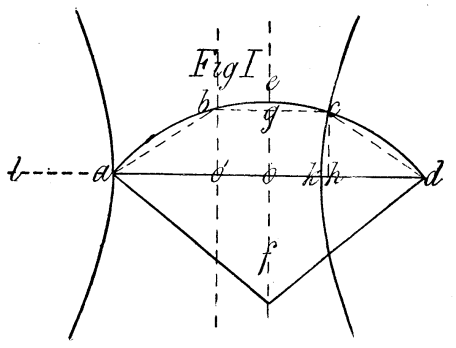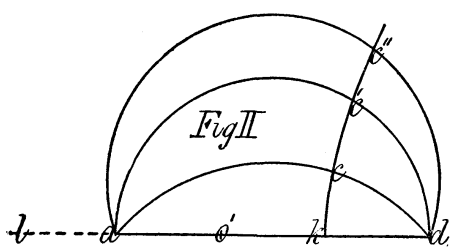FREDERIC R. HONEY, Ph.B., Yale University.
This section is from "Scientific American Supplement". Also available
from Amazon: Scientific American Reference Book.
The Trisection Of Any Angle
The following analysis shows that with the aid of an hyperbola any arc,
and therefore any angle, may be trisected.
If the reader should not care to follow the analytical work, the
construction is described in the last paragraph - referring to Fig. II.
Let a b c d (Fig. I.) be the arc subtending a given angle. Draw the
chord a d and bisect it at o. Through o draw e f perpendicular to a d.

FIG 1.
We wish to find the locus of a point c whose distance from a given
straight line e f is one-half the distance from a given point d.
In order to write the equation of this curve, refer it to the
co-ordinate axes a d (axis of X) and e f (axis of Y), intersecting at
the origin o.
Let g c = x
Therefore, from the definition c d = 2x
Let o d = D
[Hence] h d = D-x
Let c h = y
[Hence] (2x)² = y² + (D-x)²
or 4x² = y² + D²-2Dx + x²
[Hence] y²-3x² + D²-2Dx = o [I.]
This is the equation of an hyperbola whose center is on the axis of
abscisses. In order to determine the position of the center, eliminate
the x term, and find the distance from the origin o to a new origin o'.
Let E = distance from o to o'
[Hence] x = x' + E
Substituting this value of x in equation I.
y²-3(x' + E)² + D²-2D(x' + E) = o
or y²-3x²-6Ex'-3E² + D²-2Dx'-2DE = o [II.]
In this equation the x' terms should disappear.
[Hence] -6Ex' - 2Dx' = o
[Hence] -E = - D/3
That is, the distance from the origin o to the new origin or the center
of the hyperbola o' is equal to one-third of the distance from o to d;
and the minus sign indicates that the measurement should be laid off to
the left of the origin o. Substituting this value of E in equation II.,
and omitting accents -
We have
y² - 3x² + 2Dx - D²/3 + D² - 2Dx + 2D²/3 = o
[Hence] y² - 3x² = - 4D²/3
This is the equation of an hyperbola referred to its center o' as the
origin of co-ordinates. To write it in the ordinary form, that is in
terms of the transverse and conjugate axes, multiply each term by C,
i.e.,
Let √C = semi-transverse axis.
Thus Cy² - 3Cx² = - 4CD² / 3. [III.]
When in this form the product of the coefficients of the x² and y²
terms should be equal to the remaining term.
That is
3C² = - 4CD² / 3.
[Hence] C = 4D² / 9.
And equation III. becomes:
(4D² / 9) y² - (4D² / 3) x² = 16D4 / 27
The semi-transverse axis = √4D² /9 = 2D / 3
The semi-conjugate axis = √4D² / 3 = 2D / √3
Since the distance from the center of the curve to either focus is
equal to the square root of the sum of the squares of the semi-axes,
the distance from o' to either focus
= √4D²/9 + 4D²/ 3 = 4D / 3
The Trisection Of Any Angle 787 4 fig2

We can therefore make the following construction (Fig. II.) Draw a d
the chord of the arc a c d. Trisect a d at o' and k. Produce d a to l,
making a l = a o' = o' k = k d. With a k as a transverse axis, and l
and d as foci, construct the branch of the hyperbola k c c' c", which
will intersect all arcs having the common chord a d at c, c', c", etc.,
making the arcs c d, c' d, c" d, etc., respectively, equal to one-third
of the arcs a c d, a c' d, a c" d, etc.
Title Scientific American Supplement Volumes 643,
647, 664, 711, 717, 787, 794, 795, 799 and 803
Author Various Authors
Publisher Munn & Co.
Year 1888-1891
Copyright 1891, Munn & Co.
Amazon Scientific American Reference Book
~Source
Hyperbolic Trisection and the Spectrum of Regular
Polygons

